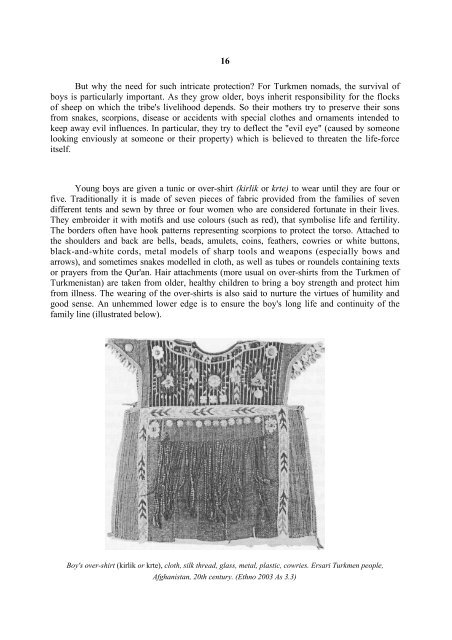download - OATG. Oxford Asian Textile Group
download - OATG. Oxford Asian Textile Group
download - OATG. Oxford Asian Textile Group
- No tags were found...
Create successful ePaper yourself
Turn your PDF publications into a flip-book with our unique Google optimized e-Paper software.
16But why the need for such intricate protection? For Turkmen nomads, the survival ofboys is particularly important. As they grow older, boys inherit responsibility for the flocksof sheep on which the tribe's livelihood depends. So their mothers try to preserve their sonsfrom snakes, scorpions, disease or accidents with special clothes and ornaments intended tokeep away evil influences. In particular, they try to deflect the "evil eye" (caused by someonelooking enviously at someone or their property) which is believed to threaten the life-forceitself.Young boys are given a tunic or over-shirt (kirlik or krte) to wear until they are four orfive. Traditionally it is made of seven pieces of fabric provided from the families of sevendifferent tents and sewn by three or four women who are considered fortunate in their lives.They embroider it with motifs and use colours (such as red), that symbolise life and fertility.The borders often have hook patterns representing scorpions to protect the torso. Attached tothe shoulders and back are bells, beads, amulets, coins, feathers, cowries or white buttons,black-and-white cords, metal models of sharp tools and weapons (especially bows andarrows), and sometimes snakes modelled in cloth, as well as tubes or roundels containing textsor prayers from the Qur'an. Hair attachments (more usual on over-shirts from the Turkmen ofTurkmenistan) are taken from older, healthy children to bring a boy strength and protect himfrom illness. The wearing of the over-shirts is also said to nurture the virtues of humility andgood sense. An unhemmed lower edge is to ensure the boy's long life and continuity of thefamily line (illustrated below).Boy's over-shirt (kirlik or krte), cloth, silk thread, glass, metal, plastic, cowries. Ersari Turkmen people,Afghanistan, 20th century. (Ethno 2003 As 3.3)
















